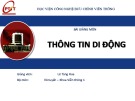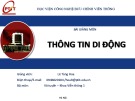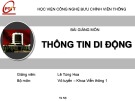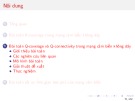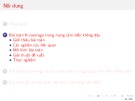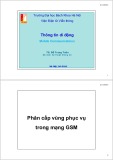
2/17/2014
1
Trường Đại học Bách Khoa Hà Nội
Khoa Điện tử Viễn thông
Thông tin di động
Mobile Communications
TS. Đỗ Trọng Tuấn
Bộ môn Kỹ thuật thông tin
Hà Nội, 8-2010
2/17/2014
2
Nội dung
•Tổng quan về thông tin di động số tế bào.
•Hệ thống TTDĐ 2G (GSM,GPRS)
•Hệ thống TTDĐ 3G (UMTS,HSDPA)
•Mạng không dây WiFi – WiMax
•Quy hoạch và định cỡ mạng 3G/UMTS

2/17/2014
3
Tài liệu tham khảo
•Giáo trình thông tin di động, ĐHBK Hà Nội
•Lý thuyết về kênh vô tuyến – Thầy Nguyễn Văn Đức
•Tính toán mạng thông tin di động số cellular - Thầy Vũ Đức Thọ
•Principles of Mobile Communication, Gordon L. Stüber
•Wireless Communications Principles and Practice, T Rappaport
•Understanding UMTS Radio Network Modelling, Planning
and Automated Optimisation, Maciej J. Nawrocki, Mischa
Dohler, A. Hamid Aghvami
•http://www.google.com
2/17/2014
4
CHƯƠNG 1
T
ổ
ng quan về thông tin di động
số tế bào
(Cellular Mobile Communications)

2/17/2014
5
5
Introduction
Cellular mobile communication
systems, or just mobile systems
are communication systems with
many access points, or base
stations. Each base station
supports its nearby geographical
area, called a cell. The user can
move around with his mobile
phone and communicate through
the nearest base station
2/17/2014
6
6
Cellular Mobile Systems

2/17/2014
7
7
Cellular Concept
• Geographic Service divided into
smaller “cells”
• Neighboring cells do not use same
set of frequencies to prevent
interference
• Often approximate coverage
area of a cell by a idealized
hexagon
• Increase system capacity
by frequency reuse.
2/17/2014
8
8
Cellular Networks
• Propagation models represent cell as a circular area
• Approximate cell coverage with a hexagon - allows easier analysis
• Frequency assignment of F MHz for the system
• The multiple access techniques translates F to T traffic channels
• Cluster of cells K = group of adjacent cells which use all of the systems
frequency assignment

2/17/2014
9
9
Cellular Concept
• Why not a large radio tower and large service area?
– Number of simultaneous users would be very limited
(to total number of traffic channels T)
– Mobile handset would have greater power requirement
• Cellular concept - small cells with frequency reuse
– Advantages
• lower power handsets
• Increases system capacity with frequency reuse
– Drawbacks:
• Cost of cells
• Handoffs between cells must be supported
• Need to track user to route incoming call/message
2/17/2014
10
10
Cellular Concept (cont)
• Let T = total number of duplex channels
K cells = size of cell cluster (typically 9,12, 21)
N = T/K = number of channels per cell
• For a specific geographic area, if clusters are replicated M times,
then total number of channels
– system capacity = M x T
– Choice of K determines distance between cells using the
same frequencies => termed “co-channel” cells
– K depends on how much interference can be tolerated by
mobile stations and path loss

